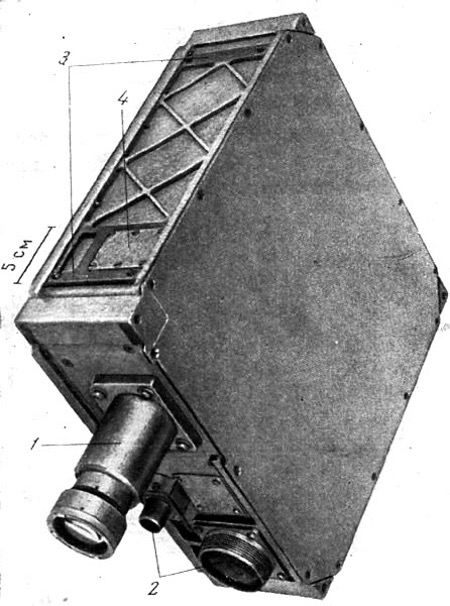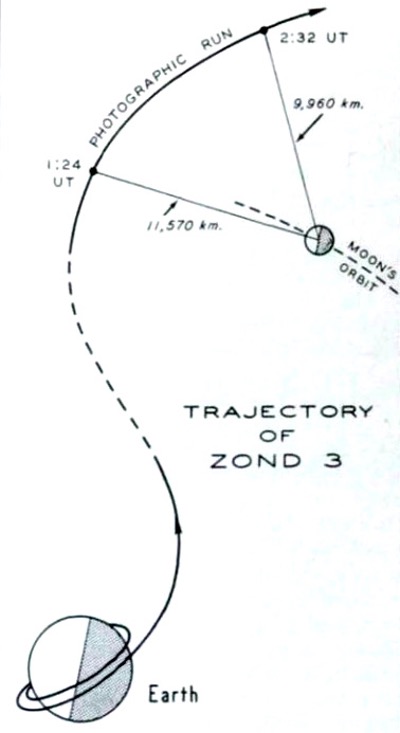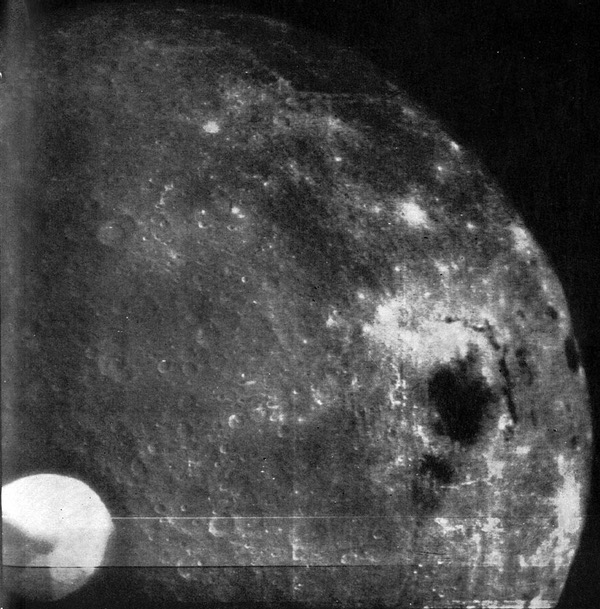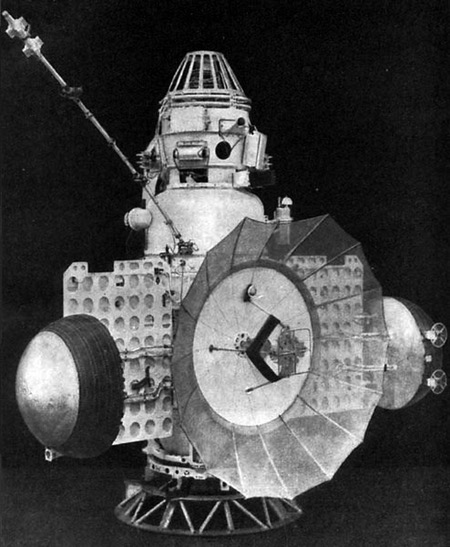The mission of Zond 3by Andrew J. LePage
|
 Russian diagram showing the advanced film-based imaging system carried by Zond 2. (credit: NASA) |
Origins of the Zond series
What would become the Zond 3 mission can be traced back to Soviet Union’s planetary probes launched in 1962 (see “If at first you don’t succeed…” Parts 1 and 2, The Space Review, March 24 and 31, 2014, respectively). Since the launch windows for Venus and Mars were only months apart in 1962, the decision was made to launch a half-dozen spacecraft built to a common design called 2MV. A total of four variants of the 2MV were built with each tailored specifically to two different missions—flyby or landing—for two different targets: Venus or Mars.
| Even before the last transmission from Mars 1 had been received, the decision had already been made to send another half dozen spacecraft towards Venus and Mars during 1964 launch opportunities using an improved spacecraft designated 3MV. |
Unfortunately, all three of the 2MV-series spacecraft launched towards Venus in August and September of 1962 never made it beyond Earth orbit due to problems with the Molniya 8K78 launch vehicle. Likewise, two of the 2MV spacecraft bound for Mars also succumbed to launch vehicle failures two months later. Only Mars 1, launched on November 1, 1962, managed to survive launch and was sent on its way to Mars. Despite the successful launch, a malfunction in the spacecraft’s attitude control system doomed the mission of Mars 1 to failure months before it ever reached its target.
Even before the last transmission from Mars 1 had been received, the decision had already been made to send another half dozen spacecraft towards Venus and Mars during 1964 launch opportunities using an improved spacecraft designated 3MV. Like its predecessors, the 3MV series of planetary explorers were designed at OKB-1 led by famed Chief Designer Sergei Korolev. As with the earlier 2MV, the 3.6-meter-tall (12-foot-tall) 3MV consisted of two sections. The first was an orbital compartment that contained control systems, power supplies, and communications gear, as well as some instrument electronics. Mounted on the exterior of this compartment was a pair of solar panels with hemispherical radiators for thermal control mounted on their ends, an umbrella-like high-gain antenna, as well as low-gain antennas and a variety of sensors. The 3MV included a number of design improvements based on the experiences with the earlier 2MV design, such as significantly more redundancy of key systems and the inclusion of a set of experimental plasma engines to serve as a backup to the conventional nitrogen gas jets used for attitude control, which had failed during the flight of Mars 1.
The second section of the 3MV was the planetary compartment that was geared towards specific investigations of the target planet. As before, the planetary compartment came in two varieties: one contained a film-based camera system and a set of ultraviolet and infrared instruments designed to study the target planet during a close flyby, while the other was a roughly spherical lander with a diameter of about 0.9 meters (3 feet), designed to detach from the orbital compartment before the encounter and touchdown on the target planet. Both the orbital and planetary compartments were pressurized to provide a laboratory-like environment for the internal equipment in order to simplify the design and testing of various systems as well as provide easier thermal control.
As with the 2MV, the 3MV design had four design variants. The 3MV-1 carried a planetary compartment designed to land on Venus, while the 3MV-2 had instruments designed to study Venus during a close flyby. Likewise, the 3MV-3 and 3MV-4 were meant to land and flyby Mars, respectively. While the 3MV incorporated many design improvements to address the problems uncovered in the 2MV spacecraft, Korolev and his engineers realized that test flights of the 3MV would be desirable to reveal any additional issues well before the launches to Venus and Mars in order to improve the chances of these missions succeeding. Since these test missions would not be directed specifically towards Venus or Mars, after launch they would receive the generic name of “Zond” which means simply “probe” in Russian.
The first Zond version was a stripped down model of the Venus lander craft designated 3MV-1A. It was to be launched into a solar orbit that would bring it back to Earth after a flight of five to six months. The entry probe would then separate from the orbital compartment and reenter Earth’s atmosphere to simulate the Venus landing mission of the 3MV-1. The second Zond variant was a modified version of the Mars flyby spacecraft designated 3MV-4A. This spacecraft was to carry a planetary compartment equipped with an updated miniaturized film-based imaging system as well as other scientific instruments. After being launched into a simulated trajectory towards the orbit of Mars, the 3MV-4A would turn its camera back towards the receding Earth at a distance of 40,000 to 200,000 kilometers (25,000 to 124,000 miles) and acquire a sequence of photographs that would subsequently be developed automatically on board. The spacecraft would then transmit its scanned photographs and other data gathered on the interplanetary environment out to distances as great as 200 to 300 million kilometers (125 to 185 million miles) as part of a long distance communications test.
 Diagram showing the trajectory of Zond 3 past the Moon. (credit: Sternberg Astronomy Institute) |
The First Zond Missions
On March 21, 1963, the Soviet government officially approved the 3MV program. It would consist of two 3MV-1A flights and a single 3MV-4A flight to be launched in 1963, as well as a total of six operational 3MV spacecraft to be launched to Venus and Mars in 1964 (See “…Try, try, again”, The Space Review, April 28, 2014). Inevitable problems during the construction and testing of the new 3MV spacecraft delayed the launch of the engineering test flights and forced the Venus mission to be scaled back to just a pair of 3MV-1 landers. In the end, both 3MV-1A Zond test flights and the first 3MV-1 Venera mission failed due to launch vehicle issues. Only the Zond 1 lander managed to survive launch on April 2, 1964, and was sent on its way to Venus. But as had happened with earlier Soviet planetary missions, Zond 1 fell victim to a growing list of problems during its flight even with its design improvements and fell silent two months before its encounter with Venus.
With this latest failure, the launch of the 3MV-4A Zond test flight, which had been scheduled for the April-May 1964 timeframe, was postponed to address ongoing issues with the 3MV design and construction. Despite the problems, Korolev and his team still intended to launch a pair of 3MV-3 landers and another pair of 3MV-4 flyby spacecraft towards Mars in November. But in addition to the ongoing hardware issues, Soviet ambitions for this Mars launch window were now being threatened by the latest revelations about Mars gleaned from ground-based observations. The newest analysis from Soviet and American astronomers indicated that the Martian atmosphere was much thinner than had been originally believed. Designed under the assumption of a denser Martian atmosphere, the 3MV-3 lander had no hope of successfully landing on Mars.
| Unlike NASA’s Mariner 4 spacecraft, the Zond 2 mission would attempt no Mars photography despite the fact that its more advanced camera system could return more than an order of magnitude more imaging data. |
With the continuing delays in the development of the Mars-bound 3MV spacecraft and the realization that the 3MV-3 lander was inadequate for its mission, Soviet officials eventually scrapped the original plans to launch four spacecraft to Mars in November 1964. Since it was already in an advanced state of preparation, it was decided instead that only the single 950-kilogram (2,094-pound) 3MV-4A test craft would be launched towards Mars. But given the poor track record of the previous planetary missions, it was recognized that the chances of this spacecraft actually surviving all the way to Mars were slim. As a result, Mars would be only a secondary objective for this mission, with the primary objective being the original engineering test flight. The 3MV-4A, which would receive a “Zond” designation, would be launched into a slow trajectory with a 249-day transit time. This would simulate a future Mars lander mission profile, with the spacecraft essentially performing a very long-duration engineering test flight.
Unlike NASA’s Mariner 4 spacecraft, this Zond mission would attempt no Mars photography despite the fact that its more advanced camera system could return more than an order of magnitude more imaging data. Instead, Zond would presumably photograph the Earth shortly after its departure as planned for the original test flight. Aside from engineering data and exercising the new imaging system, the spacecraft would acquire scientific data on fields and particles during its interplanetary cruise. If the test craft managed to beat the odds and survive its long flight to the Red Planet in good condition, it would be redirected to impact Mars and deliver a set of commemorative pennants it was carrying.
As had been feared, Zond 2 was found to be in trouble right after it was launched on November 30, 1964, when one of its two solar panels had failed to deploy properly. Even though the stuck solar panel was eventually freed 16 days after launch, Zond 2 continued to experience a frustrating series of additional system failures and was last heard from on May 2, 1965. The silent Zond 2 flew by Mars at a reported distance of 1,500 kilometers (930 miles) on August 6, 1965, three weeks after NASA’s Mariner 4 made the first successful flyby of the Red Planet (See “The mission of Zond 2”, The Space Review, May 3, 2015).
New missions
In addition the Zond 2 engineering test flight, the Soviet government had also approved more missions of the 3MV design. The latest plans called for a pair of landers and a pair of flyby spacecraft to be launched towards Venus during the November 1965 opportunity. Eventually these spacecraft were assigned the defunct 3MV-3 and 3MV-4 designations of the Mars spacecraft that were never completed and launched. In addition, the launch of one or two more 3MV-4 engineering flights were authorized in the first half of 1965 that would follow the earlier 3MV-4A mission profile to test the improvements made to the 3MV design in the wake of the Zond 2 failure.
As before, delays in the preparation of the improved 3MV spacecraft pushed the launch of the Zond test flight into the summer of 1965. But the delay also opened up a genuine opportunity for discovery for this mission as a result. As luck would have it, the Moon could be easily reached during this time of year via Zond’s departure trajectory towards the orbit of Mars, and the lighting conditions would be ideal to observe the Moon’s western hemisphere. It was proposed that instead of photographing the Earth on its way into solar orbit, the new Zond spacecraft could be directed to photograph the Moon, including most of the lunar far side that had not been photographed earlier by the Soviet Luna 3 mission in 1959. This would provide a perfect opportunity for engineers to perform a complete end-to-end test the 3MV systems during an actual planetary encounter and provide new data on the Moon in the process.
The instrument complement of this 3MV-4 flight included the advanced photo-television system capable of taking either photographs or ultraviolet spectra in the range of 250 to 350 nanometers. This system was housed inside of the planetary compartment behind portholes that allowed the instruments to view the target. Mounted on the exterior of the compartment were ultraviolet and infrared spectrophotometers sensitive to bands of 190 to 270 nanometers and 3 to 4 microns, respectively. The spectrophotometers and ultraviolet spectrometer were originally designed to study planetary atmospheres and thus were of little use in a lunar mission, but the photo-television system was going to be the star of this mission.
| Once on its way, engineers discovered that Zond 3 was experiencing no major system malfunctions unlike all of its predecessors, where problems were immediately apparent during the first communication session. |
The 6.5-kilogram (14-pound) photo-television system was basically a much-improved version of that employed six years earlier by Luna 3 and a later model flown on the unsuccessful Mars 1 mission. Images from a single 106.4-millimeter focal length f/8 lens were focused onto 25-millimeter (one-inch) photographic film. A total of 25 exposures of one-thirtieth or one one-hundredth of a second were made. Using the same film, the ultraviolet spectrometer would expose the eighth, ninth, and tenth frames, bringing the total number of exposures up to 28. After the film was exposed, it was automatically developed on board.
The dried negatives were then scanned and transmitted back to Earth in one of two formats. A quick-look format broke the photograph into 67 lines that could be transmitted back to Earth via a high-power C-band transmitter using the spacecraft’s two-meter high gain antenna in 135 seconds. A more detailed scanning of the photographs was also possible. In this mode, each photograph was broken into 1,100 lines of 860 points each that were comparable in quality to Ranger’s full-scan television images of the Moon (See “Ranger: America’s first successful lunar program”, The Space Review, February 3, 2014) but far superior to the digital imaging system used by NASA Mariner 4 mission to Mars. In this high-resolution mode, a single photograph could be transmitted over interplanetary distances in 34 minutes. Each image could be scanned multiple times to help increase the signal-to-noise ratio of the images reconstructed back on Earth.
 This is the 28th image in the sequence taken by Zond 3 on July 20, 1965 showing Mare Orientale and much of the previously unseen far side of the Moon to the left. (credit: Sternberg Astronomy Institute) |
The flight of Zond 3
For this test flight, the 960-kilogram (2,116-pound) 3MV-4 number 3 was prepared for launch (some sources claim this was a 3MV-4A spacecraft but the difference was probably irrelevant at this stage.) At 14:38 UT on July 18, 1965, what became Zond 3 launched on an 8K78 Molniya rocket into a temporary 164-by-210 kilometer (102-by-131 mile) parking orbit with an inclination of 64.8 degrees. After a short coast, the Blok L escape stage ignited, sending Zond 3 to the Moon and beyond.
Once on its way, engineers discovered that Zond 3 was experiencing no major system malfunctions unlike all of its predecessors, where problems were immediately apparent during the first communication session. Since the 3MV-4 spacecraft was so much lighter than the 1,500-kilogram (3,300 pound) E-6 lunar landers the Soviets had been launching towards the Moon at that time using the same rocket (unfortunately, with little success), Zond 3 reached the vicinity of the Moon in just half the time: a relatively short 33 hours.
At 01:24 UT on July 20, at a distance of 11,570 kilometers (7,190 miles), Zond 3 pointed its camera and other instruments towards the Moon and started taking one photographic exposure every 134 seconds. The initial images included not only the unmapped far side but also the near side so that newly discovered features could be tied into the already existing lunar mapping control net. This continued as the fast-moving probe reached its closest point to the Moon of 9,219 kilometers (5,730 miles) and then receded to a distance of 9,960 kilometers (6,190 miles) at the end of its photography session at 02:32 UT with the Moon having been viewed through an angle of about 60 degrees. After this 68-minute photography session, Zond 3 immediately developed its film as it headed into a simulated trajectory to Mars—simulated since Mars was not in position for a low-energy encounter and would not be for another year and a half.
On July 29, at a distance of 2.25 million kilometers (1.40 million miles), Zond 3 was out far enough for the sensors on its high gain antenna to lock onto the Earth and start transmitting the recorded images to waiting scientists. The images were spectacular and far superior to the ones returned six years earlier by Luna 3. Details as small as five kilometers (three miles) across could be seen in the photographs, which showed little more than a cratered wasteland. These photographs confirmed that there was a lack of maria on the Moon's far side compared to the more familiar near side, which was dominated by these dark and relatively flat basaltic flows.
| With these photographs in hand, the Soviets had mapped all but five percent of the Moon’s surface. While NASA’s Mariner 4 mission had just sent back the first images of Mars, Zond 3 had managed to send back the best images of the lunar far side with far superior quality. |
The photographs also showed no signs of the purported Mare Parvum, which some ground-based observers claimed to have seen near Mare Orientale during especially extreme librations of the Moon. Zond 3 did discover a new type of lunar feature that Soviet scientists proposed be called thalassoids. These were the battered concave-shaped remnants of basins over 500 kilometers (300 miles) across and were thought to be the precursors of maria. For some reason these far side structures were never flooded with lava to form true maria. (The term “thalassoids” fell out of official use in 1967 since these features were found to be indistinguishable from other large, unflooded basins). The spectral instruments onboard Zond 3 showed that the Moon reflected just one percent of the ultraviolet radiation hitting its barren surface. In contrast, the lunar surface reflected eighty to ninety percent in the incident infrared light, with a broad peak around 3.6 microns.
With these photographs in hand, the Soviets had mapped all but five percent of the Moon’s surface. While NASA’s Mariner 4 mission had just sent back the first images of Mars, Zond 3 had managed to send back the best images of the lunar far side with far superior quality. Even at this early stage of the mission, Zond 3 was a propaganda success after a long string of failed planetary probes and Luna missions.
Zond 3 continued to operate as it travelled farther from Earth and towards the general direction of the orbit of Mars. In addition to engineering information, Zond 3 sent back data from a complement of instruments designed to study the interplanetary environment during the long cruise. On September 16, at a distance of 12.5 million kilometers (7.8 million miles), Zond 3 used its propulsion system to change the probe’s velocity by 50 meters/second (112 mph) to simulate a mid-course correction. The spacecraft successfully retransmitted its lunar images in mid-August, mid-September, and for the last time on October 23, when it was 31.5 million kilometers (19.6 million miles) away from the Earth.
By the time of the launch of Venera 2 on November 12, 1965, the first of four spacecraft planned to be launched during this Venus window, Zond 3 had been operating for 117 days in solar orbit confirming that the 3MV design could survive the 107-day transit to Venus. Regular communication sessions with Zond 3 were maintained until March 3, 1966, at a range of 153.5 million kilometers (95.4 million miles). Although the spacecraft was not heard from afterwards, Zond 3 had managed to operate for 228 days—barely long enough to survive the typical flight time to Mars but vindicating the soundness of the improving 3MV design. Unfortunately, contact with Venera 2 and 3 (the only two of the four spacecraft to be successfully launched towards Venus the previous November) had been lost a couple of days earlier just as each spacecraft was to begin their encounter activities at Venus. The details of these missions and the aftermath will be the subject of a future article.
General References
Brian Harvey, Soviet and Russian Lunar Exploration, Springer-Praxis, 2007
Wesley T. Huntress and Mikhail Ya. Marov, Soviet Robots in the Solar System: Mission Technologies and Discoveries, Springer-Praxis, 2011
Nicholas L. Johnson, Handbook of Soviet Lunar and Planetary Exploration, Univelt, 1979
Andrew LePage, “Zond 2: Old Mysteries Solved & New Questions Raised”, Drew Ex Machina, July 17, 2014
Yuri N. Lipsky, "Zond 3 Photographs of the Moon's Far Side", Sky & Telescope, Vol. 30, No. 6, pp. 338-341, December 1965
